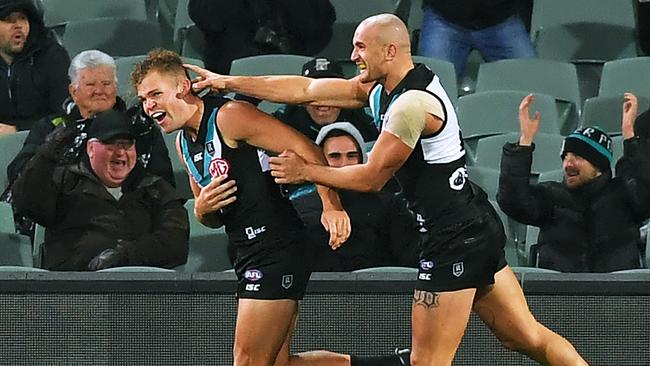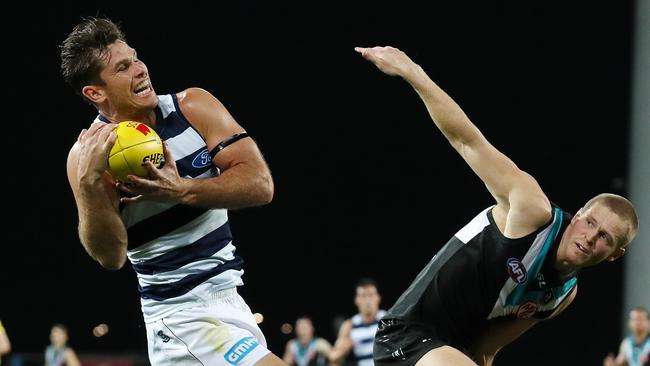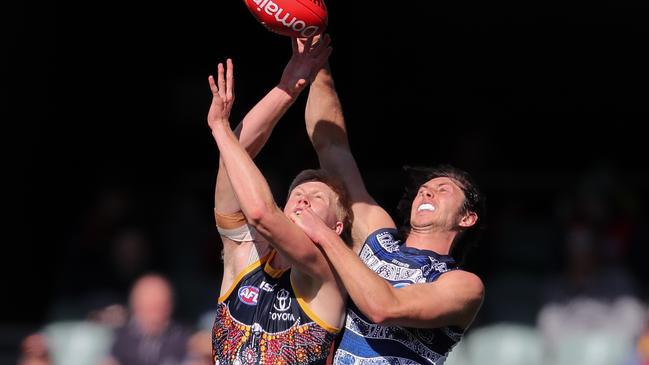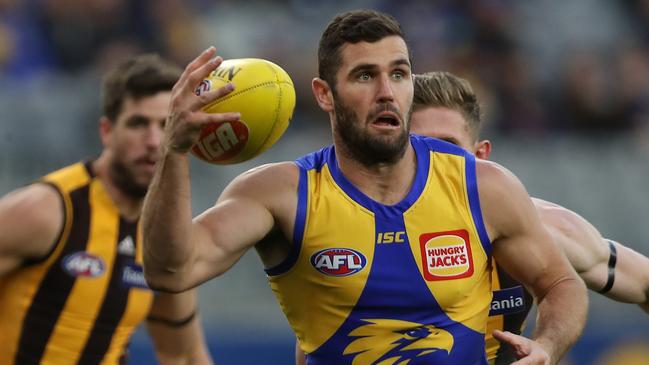Mick McGuane rates the leading premiership contenders and dismisses the chances of one top-four team
Ladder-leading Port Adelaide is more than likely to clinch the minor premiership but Mick McGuane isn’t convinced the Power’s game can stand up in the finals.

Port Adelaide
Don't miss out on the headlines from Port Adelaide. Followed categories will be added to My News.
Four teams can win this year’s AFL flag, but the side sitting on top of the ladder right now – and most likely will still be there at finals time – isn’t one of them.
There is a lot of footy to be played out, and taking into account injuries, the bye before the finals and the uncertainty of where the finals will be played, I’ve settled on Geelong, West Coast, Richmond and Brisbane Lions as my premiership contenders.
I’ve got concerns about Port Adelaide’s chances, particularly with the way the team was dismantled against Geelong in Round 12.
Kayo is your ticket to the 2020 Toyota AFL Premiership Season. Watch every match of every round Live & On-Demand. New to Kayo? Get your 14-day free trial & start streaming instantly >
Given their run home – Sydney, bye, North Melbourne, Essendon and Collingwood – they will likely finish on top and lock in the McClelland Trophy.
But that doesn’t guarantee the only piece of silverware that really matters as finals are a very different beast.
They have a strong forward half game – ranked No.1 for forward half intercept possessions, No.2 for time in forward half differential and No.3 for points from turnover differential.
Their game revolves around contest, territory and intercepts.
My reasoning for dismissing their chances comes back to their inability to defend pure ball movement, which has been a real concern in recent weeks.
We saw that most starkly against the Cats, who exposed Port Adelaide‘s ability to defend opposition ball movement in transition.
There is still time to make adjustments.
My message to Ken Hinkley, please introduce a goalkeeper to stop the easy goals out the back. Until they do they won‘t look like a premiership team.

Being super aggressive and assertive in team defence has its positives but if a quality ball using team penetrates their press they will continue to get scored against.
Hinkley needs to fix it now to save the embarrassment of potentially a straight sets finals exit.
I’m concerned about Port Adelaide’s undersized key defenders, too.
As brave and as honest as they are, they lack height against the power forwards. They have conceded 32 goals to opposition key forwards – 12th in the AFL.
Tom Hawkins exposed them with six goals; Josh Kennedy booted four goals, while Harry McKay and Jack Riewoldt also scored three goals against them.
If we drill deeper, Brisbane’s Eric Hipwood, Oscar McInerney and Daniel McStay pose serious threats against Tom Jonas, Tom Clurey and Trent McKenzie.
This year, the Lions’ trio kicked 3.4 combined, but in Round 3 last year, Hipwood kicked 6.1, McStay 2.0 and McInerney 1.0 – for a collective 9.1.

Port Adelaide‘s scoring profile is good – 4th in points for – but its conversion cannot be trusted. It has a shot-at-goal accuracy of only 42% this season, ranked 17th.
Can you trust Charlie Dixon? He has kicked 23.16, but has still missed crucial shots.
Does Justin Westhoff convert enough goals when needed? That’s questionable.
Do the midfielders hit the scoreboard enough for the amount of ball they win? No.
Robbie Gray (11.5) can be trusted. But as good as Travis Boak (5.7) is, he must kick more goals and they must get more goals out of Sam Powell-Pepper (4.10) and Ollie Wines (4.4).
READ MORE:
McGuane, Dermie choose their Big V teams for 2020
Champion Data reveals the most-improved players of 2020 at every AFL club
THE REAL CONTENDERS
1. GEELONG
Chris Scott deserves massive kudos; his leadership in this hub period has been exceptional, along with leaders Joel Selwood, Patrick Dangerfield, Tom Hawkins, Mark Blicavs, and Harry Taylor.
They are as complete as any team in the competition at the moment.
Player depth does that.
They have a perfect blend of attack and defence – No. 1 in both areas.
The management of the playing group has been first rate. Just look at how they eased Dangerfield into attack at periods to ease the burden on him.
The Cats are controlling games – No. 1 for disposals differential and No. 2 to the Eagles in marks.
They starve the opposition of the ball. If you don’t apply pressure or match their volume of disposals, look out!

Their defence gives up a miserly 52 points per game, and I‘ve been impressed with emerging defenders Jack Henry and Mark O’Connor.
Their attack scores heavier than any other side (953), they have the best key forward in the game in Tom Hawkins, while Gary Ablett will be the perfect finals inclusion.
Their mids hunt the footy (No. 1 for contested possessions) and share the load better than in recent seasons.
They have the ability to go into different modes as we witnessed against Port Adelaide – moving the ball in quickly to Hawkins, which isn’t always their style.
One room for improvement is their centre bounce work. The Cats have conceded over two goals a game from an opposition centre bounce clearance – 18th.
2. WEST COAST
The Eagles have the third highest kick-to-handball ratio, which explains their marking prevalence and why they are a good score-from-turnover side (just under seven goals per game).
They can be trusted when going forward to score with Josh Kennedy, Jack Darling, Oscar Allen, Jamie Cripps and Liam Ryan.
At the other end, Jeremy McGovern, Tom Barrass, Shannon Hurn and Brad Sheppard control the air.
The Eagles are now into a block of Queensland games – which started last night – with Essendon, Western Bulldogs, St Kilda and North Melbourne to come. I’m hoping their competitive attitude in the hub has changed from earlier in the year.
One area of concern is their 18th ranking for loose balls (-9.4) and ground ball differential (-14.8).
If I was Adam Simpson, I would say let’s initiate rather than replicate. What they are currently returning at ground level needs to change.
Get proactive around stoppage, hunt the loose footy and it will increase F50 opportunities. I remember pointing to a similar concern on the eve of the 2018 finals.
West Coast fixed it, and went on to win the premiership.

3. RICHMOND
The Tigers – at their absolute best – are as destructive as any side.
The big disclaimer is whether missing premiership stars David Astbury, Dion Prestia, Shane Edwards and Josh Caddy can return match-hardened for the finals.
How this dilemma is managed might determine the Tigers‘ hope of a third flag in four seasons.
Even though their form has been solid, they have conceded a score from 47% of their opposition inside 50s – which ranks them 18th. That’s not good enough.
Richmond must tighten up defensively to stop leaking scores.
The Tigers still have the AFL’s most influential player – Dustin Martin. His midfield creativity, clearance work at centre bounces and ability to provide another avenue to goal when forward makes him a match winner. Champions thrive in finals.
4. BRISBANE LIONS
Contest and territory is Brisbane’s mantra. We know they are a “get it forward“ team.
But that’s only part of the equation. You have to take your chances, and that’s costing the Lions right now.
Their shots at goal accuracy sits at 40%, ranked 18th.
If you can’t improve this in the home-and-away season, good luck trying to turn the switch during the heat of the finals.
They blew an early chance against Richmond in last year‘s qualifying final, and it cost them their season.
Goalkicking is about responsibility. Great players and teams respond to the pressure; the Lions haven‘t shown us yet they can do that.
It’s time to get mentally stronger and seize the moment.
Their 2020 return of 124 goals and 159 behinds is poor.
Hugh McCluggage is a case in point. He has kicked 5.15. Not good enough for a player of his ilk to lack the composure and trust in his feet to get the job done.
He’s not the only one!
It‘s time for the Lions to make the most of their chances or run the risk of blowing another great opportunity.
